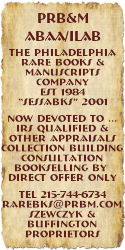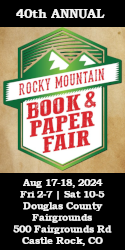Ephemeridae or Paper for More Than a Day?
Several weeks ago, after months of dithering, I reluctantly brought two of our oldest computers to the local transfer station and dropped them into the scrap-metal bin, while anything left on the hard-drives (articles, photos, documents, e-mails and the like) went along for the ride. One of them, I believe, had my last 5-1/4 inch floppy drive so any remaining 5-1/4 inch diskettes are now about as readable (to me) as a collection of Akkadian documents recorded on Babylonian clay tablets.
It sort of makes me wonder about the ultimate fate of “libraries” stored on Kindles and similar electronic readers. If college kids from the 1950s figured out how to play with used pie tins from the Frisbie Pie Company of Bridgeport, CT., what’s to prevent a little aerodynamic re-design so Kindles can be used as toys when they’re no longer readable? Ultimate Flying Kindles anyone?
A lot of the material we call ephemera isn’t all that ephemeral (unless it’s an incoming e-mail that we dump seconds after looking or not looking at it). Electronically-stored words and images may stick around for a while (see above), but paper ephemera can last for centuries after its “sell by date” has come and gone. Interestingly, the etymology of “ephemera” is tied to entomology (how often do you get to use both of those words in the same sentence?), since day-flies or may-flies and the like are classified as “ephemeridae” or insects that in their adult stage last for only a day. Johnson is sometimes credited with broadening the meaning to include paper. Or is it the other way around?
Some years ago, probably while John Major was Prime Minister, Raquel peeled two rain-soaked political posters from the middle of Southampton Row, somewhere between Russell Square and Holborn. The “Socialist Worker. Fight the Cuts. Sack the Tories” message had been printed in very large type on two sheets of thick paper stock, stapled back-to-back around a stick and carried in a parade that had just ended. Most of the signs probably ended up in dust bins, but this one had been flattened on the wet pavement with identifiable tire tracks still clearly visible. We brought them back to the hotel to dry out and now, still stapled back-to-back, they adorn the wall, along with other posters, in the piano-bar area of our basement. Because of the instincts of social and political memorabilia collectors, future historians will have more to work with, and I suspect the same could be said of other areas of collecting interest.
*
After AB Bookman’s Weekly stopped publishing at the end of 1999 I recycled most of the back issues, guessing from my own experience that ephemera relating to the antiquarian book trade is of little or no interest to ephemera collectors. I did, however, preserve my run of the AB Bookman’s Yearbook.
The old “AB” began life in January of 1948 as a spin-off from the “Books Wanted” and “Books for Sale” sections of Publishers’ Weekly. It thrived as a separate weekly publication and in July of 1953 R.R. Bowker sold it to Sol M. Malkin who, with his wife Mary Ann, ran it until about 1974 when it was sold to Jacob Chernofsky, the managing editor. Jake continued for another 25 years and at the end of 1999 it sort of disappeared without notice or explanation.
In a “Special Science Fantasy Issue” of September 3, 1949 (Volume IV, No. 10) I read that Jacob Blanck and Edward Lazare are listed as contributing editors and according to the Trade News section “Dr. A.S.W. Rosenbach, head of The Rosenbach Company, is recovering slowly after a long, severe illness.” The inside back cover carried a display ad for the 1949 American Book-Prices Current, also published by R.R. Bowker, and several years later Bowker would sell ABPC to AB’s contributing editor, Edward Lazare. It’s rained a lot since.
The first Yearbook (1948) was only 64 pages, but by 1957 it had developed into a rather substantial, soft-cover volume of 546 pages that by itself was worth more than the cost of the annual subscription of $7.00 that included both the weeklies and the yearbook. The 1957 “Bookman’s Yearbook” included 11 substantial articles on a variety of topics by Lawrence Clark Powell, Betty Rosenberg. Gordon Williams and others; 189 display ads from specialist book publishers; 641 display ads from most of the important antiquarian booksellers of the period; permanent “want lists” from book-search services; and a 8-1/2 page index.
The advertisements placed by the booksellers in which they publicized their areas of interest and expertise sometimes tell us more about the booksellers themselves than the material being sought or offered for sale. In a few cases, those ads are clues from the past reminding or informing ephemerists about who the more prominent members of the trade were. Of the 641 booksellers included in the 1957 Yearbook, a few are listed here. Some of the names you may recognize:
John Scopes (Albany, NY), an Americana specialist; Roy Vernon Sowers (Los Gatos, CA), incunabula, early science & medicine; Cedric Robinson (Windsor, CT), Americana; Poe Book Shop (Baltimore, MD), Civil War & the South; Bob Kolvoord aka “Old Settler Bookshop” (Walpole, NH), mountain climbing and polar regions; George S. MacManus (Philadelphia, PA), Americana; Leary’s Book Store (Philadelphia, PA), with a general stock of 900,000 volumes at the time; Leon Kramer (New York, NY), labor and socialism; Elizabeth Woodburn (Hopewell, NJ), horticulture; Seven Bookhunters (New York, NY), a famous search service of the period; Biblio & Tannen (New York, NY), Americana; Shorey Book Store (Seattle, WA), a large general book store; Caravan Book Service (Jamaica, NY), nautical and related; Richard S. Wormser (Bethel, CT), whose ad announcing “I have moved to the country” was a harbinger of bookselling’s demographic shift that continues to this day; James F. Drake (New York, NY), literary first editions; Edward Eberstadt (New York, NY), Americana; Goodspeed’s (Boston, MA), two famous landmark bookshops, both gone; House of El Dieff (Jamaica, NY), first editions, presentation copies; Dauber & Pine (New York, NY), Americana; Peter Decker (New York, NY),
Americana; Howard Mott (Sheffield, MA), “moved to the country” before Richard Wormser and by last report still in business.
From about 1963 onward the yearbooks were published in two parts – at first Part II was a small paper supplement, but by 1967 both Parts I & II were equally substantial paper-bound volumes. In 1973 AB celebrated its Silver Jubilee and, as it turned out, the half-way point of its existence. The yearbooks for 1973 and 1974 were combined into a single two-volume set – the hiatus occurring during the period when there was transfer of ownership from the Malkins to Chernofsky. There were still well over 600 display ads, but auctions houses, specialist publishers, and book-related services were increasing their profile and total page exposure.
The 2000 AB Yearbook was the last, with no warning or announcement that the plug was about to be pulled. A quick count of the display ads (there were only 111) and a noticeable increase in the size of the type fonts to help fill space were obvious clues that something was amiss and that perhaps its business model had been superseded. And the weekly issues were getting much thinner mainly because the Internet was making searching for everyday “reading copies” of out-of-print books so much easier and faster. The AB’s goal of “getting the right book, to the right party, at the right place, at the right time, at the right price” had been simplified by Bill Gates and a large cohort of independent software writers. (One of the more important pioneers in this field was Tom Sawyer from Newark in upstate New York, a talented software engineer who wrote most of the code for Interloc, a book search engine that later became Alibris) At any rate, after the genie was out of the bottle, the problem quickly became one of vetting the sellers and the quality of some of the books being offered, a hot topic that continues to generate a great deal of comment.
In many ways the old AB Bookman’s Yearbook served a purpose similar to that of the annual city directories that were published in many parts of the country during the late 19th and early 20th centuries. Nowadays many of them have been digitized and are available in PDF format on the Internet for the use of social historians and people doing genealogical research – if city directories in any format are still being compiled these days, I’m completely unaware of it.
Even though the time for publications such as AB Bookman’s Weekly (that served the very useful purpose of providing a sort of food chain whereby books would find their way from part-time quoter and book scout to the upper echelons of the trade) has come and gone, those that remain can survive by recognizing change and adapting to it. With some notable exceptions, at present it appears that the higher-profile auction houses have come to dominate the antiquarian and rare book business – and with the decline of traditional booksellers’ catalogues, the lower and middle levels of the trade have become largely invisible and undocumented. Incidentally, the magazine you are now holding has just completed 26 years of publication.
*
By the time you read this we expect to be somewhere between Cazenovia and Jekyll Island, planning to return in mid-March to begin our 27th year and, we hope, another long glorious season of messing about in the garden. I really should be using the plural because in addition to beds and borders of flowering annuals and perennials, we also maintain a substantial vegetable or “kitchen” garden as they’re sometimes called in the old gardening books. The advantages of a vegetable garden are many – besides making good, healthy food a relatively minor item in the household budget, when properly laid out and cared for they can be aesthetically pleasing and an integral part of good landscape design.
The extraordinary amount of snow we’ve received so far this winter has actually been rather helpful. Shortly after returning from Italy in mid-November the snow began to fall, very little at first, but by the time winter officially began on December 22nd we’d already accumulated somewhere between 75 and 80 inches that served as an effective insulating blanket saving our remaining swiss-chard, beets, brassica, and other greens from the hard frosts that would have otherwise spoiled them for table use. It may seem counter-intuitive, but the unusual weather prolonged the season allowing us to harvest fresh vegetables until nearly the end of the December.
*
Most of you know Anthony Marshall from his occasional “Notes from the Antipodes” that appears in BSM from time to time. His next article, on the subject of how he came to abandon selling books on the Internet, will be published in our next issue and may be somewhat controversial as well as entertaining. Mr. Marshall, owner of Alice’s Bookshop in Melbourne (Australia) and the author of several collections of essays, will be traveling to Cazenovia in late June and will be autographing copies of “Fossicking for Old Books” (Melbourne, 2004) at the Cooperstown Antiquarian Book Fair on June 25th of this year. More details will be published in the May/June issue.

























